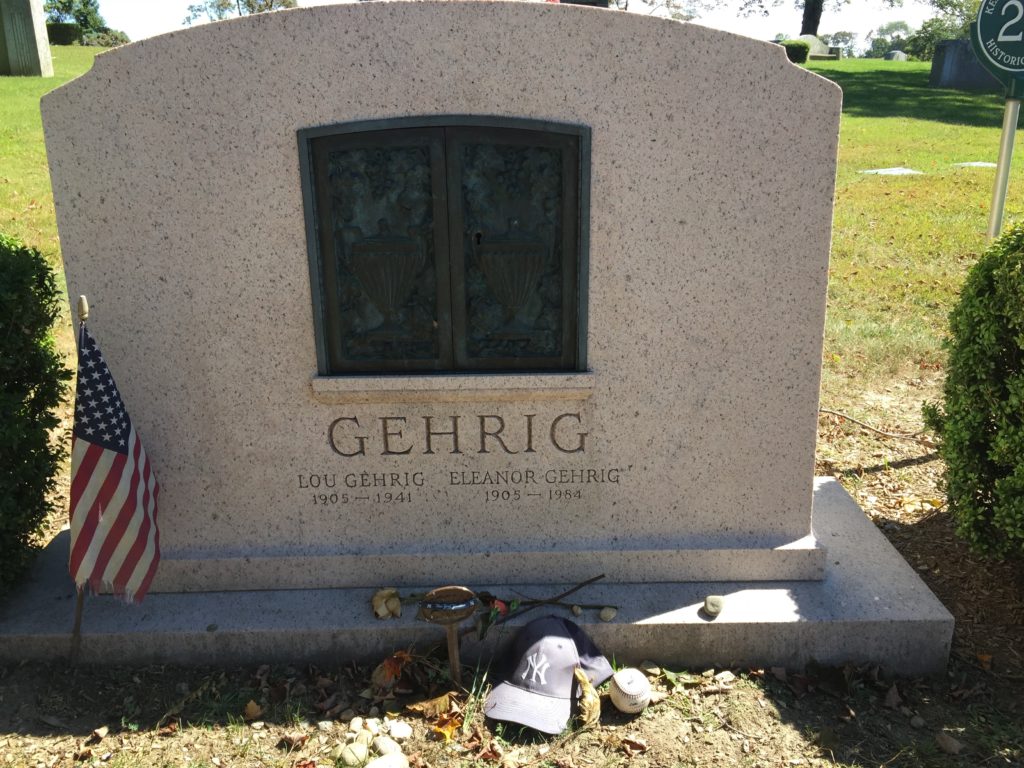Erik Visits an American Grave, Part 688
This is the grave of Lou Gehrig.

Born in 1903 in Manhattan, Heinrich Ludwig Gehrig was the son of German immigrants. His father was a drunk sheet-metal worker who sometimes worked. His mother was a maid who kept the family together, even though he lost multiple sisters to childhood death. From the time he was a child, he worked to help make money for the family. He also did not speak a word of English until he was 5.
Well, Gehrig found a way out. He was a baseball prodigy. He graduated from high school in 1921 and then spent two years at Columbia, where he was actually on a football scholarship and majoring in engineering. But he really wasn’t much of a student. John McGraw suggested he fake his name to play semi-pro ball without ruining his amateur eligibility. He did, but it didn’t work. He was suspended for a year. He came back in 1923. A Yankees scout saw him and convinced him to sign, amazed by his left-handed power. Yeah, I’d say that was a good signing.
Gehrig played a couple of years of minor league ball in Hartford in 1923 and 1924 while getting a few at bats with the Yankees. By 1925, he was mostly the team’s regular first baseman, despite being a pretty terrible fielder, which would not really improve. But when you hit like Lou Gehrig, who cares. By 1926, he was a dominant force, by 1927 the MVP, hitting a mere 373/474/765 with 47 home runs and 173 RBIs. Domination would continue for a decade, though his only other MVP was in 1936. What do you even say here? He led the league in home runs 3 times, in RBIs 5 times, in runs 4 times. He crossed Baseball Reference’s legendary 10 WAR level twice, in 1927 and 1934, hitting 8 WAR a mere 7 additional times. He drove in 185 runs in 1931. Of course, he played in 2,130 consecutive games, though this is not a statistic I find particularly interesting and valuable, possibly because I watched Baby Boomers orgasm about Cal Ripken being a scrappy white who just showed up for work every day unlike those flashy players in their Cadillacs and hip hop when the Orioles shortstop broke that streak.
There’s not really too much to say that hasn’t already said about Gehrig’s demise from ALS. That was a disease almost unknown to the American public when he was diagnosed with it in 1939. His playing had fallen apart that year and he stepped away when he could no longer bring it. On July 4, Gehrig gave his famous “Luckiest Man on the Face of the Earth” speech, though he was by no means lucky. Realizing he was going to die, MLB had him elected to the Hall of Fame that year, making an exception to its 5 year rule, as if there was any question whether he would be inducted. Fiorello LaGuardia actually gave Gehrig a job as the head of the city’s parole commission. Even though no one really expected Gehrig to do anything, he took it seriously and did his job as long as he could. But that wasn’t too long. He died in 1941, at the age of 37.
Lou Gehrig is buried in Kensico Cemetery, Valhalla, New York.
If you would like this series to visit other first basemen, you can donate to cover the required expenses here. According to Baseball Reference, Gehrig is the greatest first baseman in history and that seems pretty uncontroversial. Albert Pujols ranks 2nd. If you would like this series to visit other first baseman, you can donate to cover the required expenses here. Jimmie Foxx, who ranks 3rd, is in Miami. Cap Anson is 4th and I’ve already said hello to that racist trash. Roger Connor is 5th and is in Waterbury, Connecticut. Previous posts in this series are archived here.


